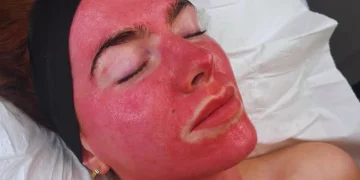Grainy Skin Texture on Face? Here’s How I Fixed It!
The Moment I Realized My Skin Wasn’t as Smooth as I Thought
I used to struggle with grainy skin texture on my face for years, and it always felt like no matter what I tried, I couldn’t achieve that smooth, radiant look.
My skin often felt rough, with dry patches, clogged pores, and occasional breakouts. I wondered, why does the skin on my face feel grainy, and more importantly, how can I fix it?
After much trial and error, I finally found a routine that transformed my skin.
Understanding Grainy Skin Texture on Face
Before diving into solutions, let’s talk about the root causes. Grainy skin texture on the face can be caused by:
- Dead Skin Buildup: If you’re not exfoliating regularly, dead skin can accumulate, making your skin feel rough.
- Dryness and Dehydration: Dry, flaky skin lacks moisture, leading to dry, grainy skin on the face.
- Enlarged or Clogged Pores: Dirt, oil, and dead skin can clog pores, giving skin an uneven texture and causing rough skin texture and large pores.
- Acne Scars and Bumps: Past breakouts may leave behind uneven skin texture.
- Aging and Sun Damage: Over time, skin loses collagen and elasticity, contributing to roughness.
- Environmental Factors: Pollution, harsh weather, and lack of skincare protection can make the skin feel grainy and dull.
Once I understood what was causing my grainy skin texture on my face, I started experimenting with different treatments to see what would actually make a difference.
Why Does the Skin on My Face Feel Grainy?

You might be wondering, why does the skin on my face feel grainy all of a sudden? The truth is, sudden changes in skin texture can be caused by:
- Changes in Weather: Cold weather can lead to dry, flaky skin, while humidity can cause clogged pores.
- Hormonal Fluctuations: Stress, diet, and hormonal shifts can impact skin texture.
- Product Build-Up: Using too many heavy or occlusive skincare products without proper cleansing can lead to congestion.
- Excessive Exfoliation: Over-exfoliating can weaken the skin barrier, leading to irritation and roughness.
Read: Can Coconut Milk Curdle?
How to Smooth Skin Texture on Face – What Finally Helped Me
After trying countless products and methods, here’s what truly helped me get rid of grainy skin texture on my face:
Exfoliating the Right Way
At first, I thought scrubbing my face daily would help. Big mistake! Over-exfoliating only made my skin irritated and more textured.
Instead, I found balance with:
- Chemical Exfoliation: Products with glycolic acid, lactic acid, or salicylic acid worked wonders. I use a gentle exfoliating toner 2-3 times a week.
- Physical Exfoliation (Occasionally): Once a week, I use a mild scrub with round beads (no harsh scrubs with jagged edges!) to slough off dead skin.
- Enzyme-Based Exfoliation: Papaya and pineapple enzymes work gently to dissolve dead skin without irritation.
Hydrating Like Never Before
My grainy skin texture on my face was partially due to dehydration.
Here’s what helped:
- Hyaluronic Acid Serum: This locks in moisture and plumps the skin.
- Face Oils: Contrary to what I believed, adding a lightweight oil (like rosehip or squalane) actually helped smooth my texture.
- Drinking More Water: I noticed a real difference when I started drinking at least 8 glasses of water daily.Using a Humidifier: This helped keep my skin hydrated, especially in dry seasons.
Using Retinol for Skin Renewal
Retinol was a game-changer! It sped up my skin’s renewal process, helping to smooth out bumps and fine lines.
I started with a low concentration twice a week, gradually increasing usage as my skin adjusted.
SPF: The Most Important Step
Sun damage worsens grainy skin texture on the face, and I didn’t realize how much I was contributing to my problem by skipping sunscreen.
Now, I wear SPF 30+ every single day, no exceptions!
I also:
- Use a Vitamin C Serum in the Morning: It helps protect my skin from environmental stressors.
- Wear Hats & Sunglasses: For extra UV protection.
- Reapply SPF Throughout the Day: Especially when outdoors for long periods.
Grainy Skin Texture on Face Home Remedies That Actually Worked
For those looking for grainy skin texture on face home remedies, these were surprisingly effective:
- Honey & Yogurt Mask: The lactic acid in yogurt gently exfoliates while honey hydrates.
- Aloe Vera Gel: Soothing and moisturizing, it helped reduce redness and bumps.
- Oatmeal Scrub: Finely ground oats mixed with milk made for a great gentle exfoliant.
- Turmeric & Milk Paste: Helped brighten my skin and reduce rough patches.
Grainy Skin Texture on Face Treatment – When to Seek Professional Help
While my skincare routine improved my skin drastically, I did eventually try professional treatments for deeper results.
Here are some options worth considering:
- Chemical Peels: These can deeply exfoliate and help fade acne scars.
- Microneedling: Stimulates collagen production to smooth out rough skin.
- Laser Resurfacing: Targets deep scars and uneven skin texture.
- RF Microneedling: A more advanced treatment that combines radiofrequency with microneedling for firmer, smoother skin.
If home treatments aren’t giving you the results you want, a dermatologist can guide you toward the best grainy skin texture on face treatment options.
How to Get Rid of Grainy Skin Texture on Face – My Ultimate Routine
Here’s a simple, effective routine that worked for me:
Morning Routine
- Gentle cleanser
- Vitamin C serum
- Lightweight moisturizer
- Sunscreen (SPF 30+)
Night Routine
- Double cleanse (especially if wearing makeup)
- Exfoliate (2-3 times a week)
- Retinol (on alternate nights)
- Hydrating serum or facial oil
- Rich moisturizer
Final Thoughts – Consistency is Key!
The biggest lesson I learned? Consistency is everything.
Improving grainy skin texture on the face isn’t about finding a miracle product, it’s about creating a skincare routine and sticking with it.
By exfoliating properly, keeping my skin hydrated, using retinol, and protecting my skin from the sun, I finally achieved the smooth, glowing skin I always wanted.
If you’re struggling with grainy skin texture on your face, don’t lose hope! Start small, be patient, and your skin will thank you.
Have you found any remedies that worked wonders for your skin? Share your experiences below!
Read: Aloe Vera and Honey – The Ultimate Duo for Radiant, Healthy Skin














